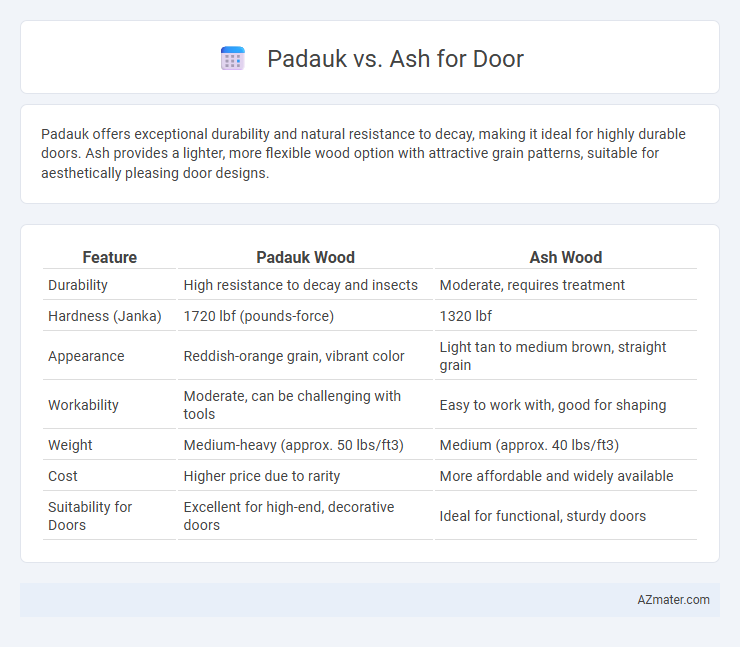Padauk offers exceptional durability and natural resistance to decay, making it ideal for highly durable doors. Ash provides a lighter, more flexible wood option with attractive grain patterns, suitable for aesthetically pleasing door designs.
Table of Comparison
| Feature | Padauk Wood | Ash Wood |
|---|---|---|
| Durability | High resistance to decay and insects | Moderate, requires treatment |
| Hardness (Janka) | 1720 lbf (pounds-force) | 1320 lbf |
| Appearance | Reddish-orange grain, vibrant color | Light tan to medium brown, straight grain |
| Workability | Moderate, can be challenging with tools | Easy to work with, good for shaping |
| Weight | Medium-heavy (approx. 50 lbs/ft3) | Medium (approx. 40 lbs/ft3) |
| Cost | Higher price due to rarity | More affordable and widely available |
| Suitability for Doors | Excellent for high-end, decorative doors | Ideal for functional, sturdy doors |
Introduction to Padauk and Ash Wood
Padauk wood, derived from tropical hardwood trees primarily found in Africa and Southeast Asia, is renowned for its vibrant reddish-orange hue and exceptional durability, making it ideal for high-end doors. Ash wood, native to North America and Europe, offers a light-colored, straight-grained texture known for its strength and shock resistance, often favored for traditional and rustic door designs. Both woods provide excellent structural integrity and aesthetic appeal, with Padauk standing out for its rich color and Ash prized for its flexibility and pale finish.
Origin and Availability of Padauk and Ash
Padauk, primarily sourced from Southeast Asia and Africa, is renowned for its vivid reddish-orange hue and durability, making it a popular choice for decorative doors. Ash, native to North America and parts of Europe, offers a lighter color with excellent strength and shock resistance, favored for both traditional and modern door applications. Availability of Padauk can be limited and more expensive due to its exotic origin, whereas Ash is generally more abundant and cost-effective in temperate regions.
Appearance and Color Variations
Padauk exhibits a rich, vibrant reddish-orange hue that deepens over time, offering a striking visual appeal ideal for statement doors. Ash typically presents a lighter, more neutral palette ranging from creamy white to pale brown, featuring pronounced grain patterns that create a subtle yet elegant look. The bold color variations in Padauk contrast with the understated, natural tones of Ash, allowing for distinct aesthetic choices in door design.
Durability and Strength Comparison
Padauk wood exhibits superior durability and resistance to decay compared to Ash, making it more suitable for exterior door applications exposed to moisture and pests. While Ash is known for its excellent shock resistance and flexibility, Padauk's higher density enhances its overall strength and longevity for heavy-use door installations. Both woods offer good mechanical properties, but Padauk's natural oils contribute to longer-lasting performance in harsh environmental conditions.
Workability and Finishing Qualities
Padauk exhibits excellent workability due to its fine, even texture and natural oils, allowing smooth sanding and easy shaping without much effort. Its finishing qualities are superior, providing a rich reddish hue that enhances with clear coatings and polishes to a vibrant, lustrous surface. Ash, while also workable, tends to be tougher and more fibrous, requiring sharper tools and careful sanding, and it finishes with a lighter, more neutral tone that highlights its natural grain patterns effectively.
Resistance to Moisture and Decay
Padauk offers superior resistance to moisture and decay compared to Ash, making it an exceptional choice for door construction in humid environments. Its natural oils and dense grain structure enhance durability against fungal attacks and water penetration, extending door lifespan. Ash, while strong and flexible, tends to absorb moisture more readily, which can lead to faster decay and warping over time in moist conditions.
Cost and Value Considerations
Padauk offers a vibrant reddish hue and excellent durability, often commanding a higher price due to its exotic nature, making it a premium option for doors that require longevity and aesthetic appeal. Ash, with its lighter color and strong, flexible grain, tends to be more cost-effective, providing good value for budget-conscious projects without compromising on strength. Choosing between Padauk and Ash depends on balancing the desire for vibrant appearance and exotic status against budget constraints and practical performance needs.
Environmental Impact and Sustainability
Padauk wood is a highly sustainable choice due to its fast growth rate and lower environmental footprint, commonly sourced from responsibly managed plantations. In contrast, Ash, while durable, often comes from slower-growing trees that may be harvested from natural forests, raising concerns about deforestation and habitat disruption. Choosing Padauk for doors supports eco-friendly practices by promoting renewable resources and reducing carbon emissions associated with logging and transportation.
Best Use Cases for Padauk and Ash Doors
Padauk wood is highly valued for doors requiring rich reddish hues, exceptional durability, and resistance to termites, making it ideal for exterior doors exposed to harsh weather conditions. Ash wood offers a lighter color with excellent shock resistance and flexibility, making it perfect for interior doors that benefit from a blend of strength and aesthetically pleasing grain patterns. Both woods provide robust performance, but Padauk's hardness suits heavy-duty exterior applications, while Ash excels in decorative and functional interior door solutions.
Conclusion: Choosing Between Padauk and Ash for Your Door
Padauk offers superior durability and a striking reddish hue, making it ideal for doors requiring long-lasting strength and visual appeal. Ash provides excellent workability and a lighter, more neutral tone, suitable for those seeking a classic, versatile look with reliable performance. Selecting between Padauk and Ash depends on your preference for color vibrancy and structural resilience versus subtle aesthetics and ease of finishing.

Infographic: Padauk vs Ash for Door
 azmater.com
azmater.com